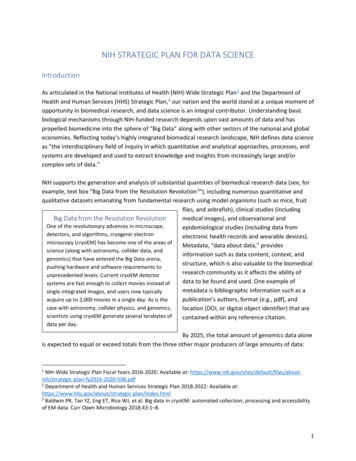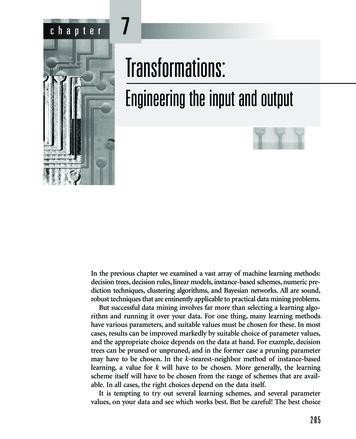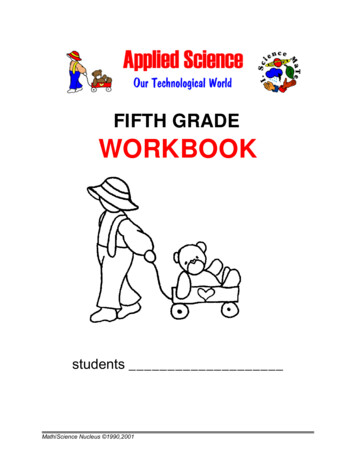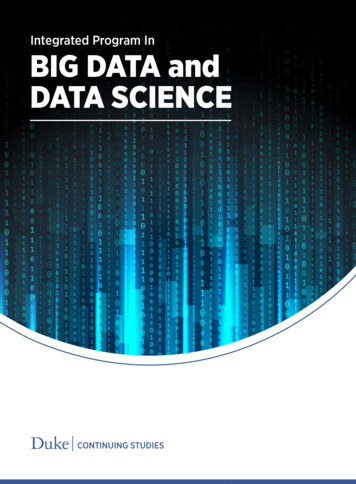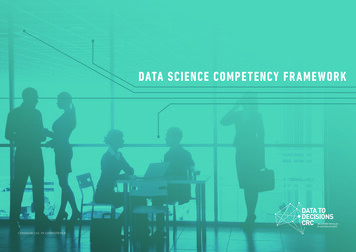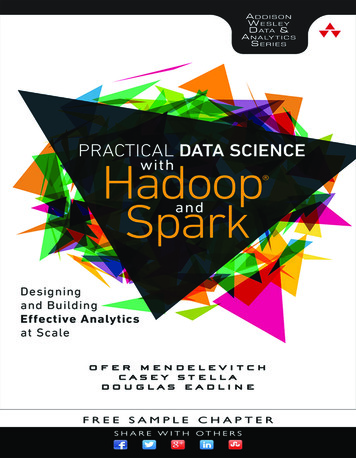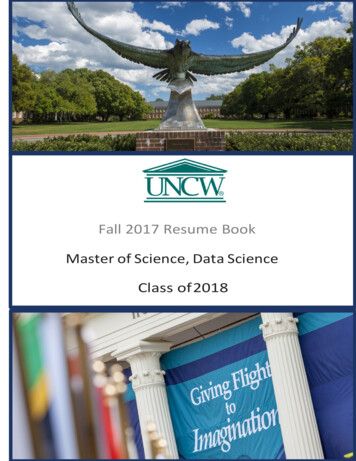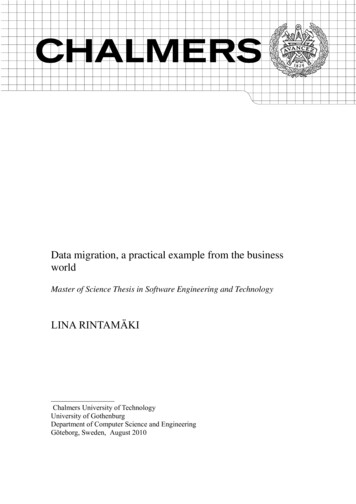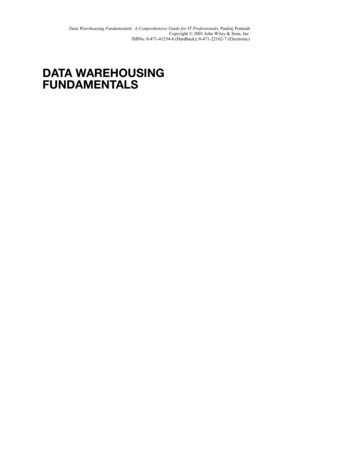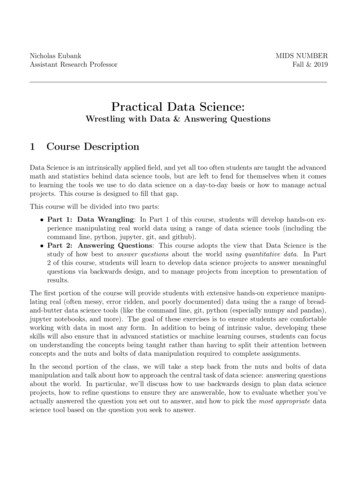
Transcription
Nicholas EubankAssistant Research ProfessorMIDS NUMBERFall & 2019Practical Data Science:Wrestling with Data & Answering Questions1Course DescriptionData Science is an intrinsically applied field, and yet all too often students are taught the advancedmath and statistics behind data science tools, but are left to fend for themselves when it comesto learning the tools we use to do data science on a day-to-day basis or how to manage actualprojects. This course is designed to fill that gap.This course will be divided into two parts: Part 1: Data Wrangling: In Part 1 of this course, students will develop hands-on experience manipulating real world data using a range of data science tools (including thecommand line, python, jupyter, git, and github). Part 2: Answering Questions: This course adopts the view that Data Science is thestudy of how best to answer questions about the world using quantitative data. In Part2 of this course, students will learn to develop data science projects to answer meaningfulquestions via backwards design, and to manage projects from inception to presentation ofresults.The first portion of the course will provide students with extensive hands-on experience manipulating real (often messy, error ridden, and poorly documented) data using the a range of breadand-butter data science tools (like the command line, git, python (especially numpy and pandas),jupyter notebooks, and more). The goal of these exercises is to ensure students are comfortableworking with data in most any form. In addition to being of intrinsic value, developing theseskills will also ensure that in advanced statistics or machine learning courses, students can focuson understanding the concepts being taught rather than having to split their attention betweenconcepts and the nuts and bolts of data manipulation required to complete assignments.In the second portion of the class, we will take a step back from the nuts and bolts of datamanipulation and talk about how to approach the central task of data science: answering questionsabout the world. In particular, we’ll discuss how to use backwards design to plan data scienceprojects, how to refine questions to ensure they are answerable, how to evaluate whether you’veactually answered the question you set out to answer, and how to pick the most appropriate datascience tool based on the question you seek to answer.
2For Whom Is This Course Meant?2.1Pre-RequisitesThis course is primarily designed for incoming Masters in Data Science (MIDS) students. As such,the only pre-requisites are the three things taught in the MIDS student boot-camp: A familiarity with basic python A familiarity with basic statistics (i.e. what you’d get from an intro stats course) A familiarity with git and githubMIDS students:The only knowledge assumed is the portion of these topics covered in boot-camp, so unless youskipped (the mandatory) bootcamp, you should be good.MIDS students should also be aware that while many of the topics in the course schedule mayseem like things you covered over the summer, we will be exploring them in much more depth, andpracticing techniques you’ve learned with much messier real-world data. Your experience fromDataCamp will make these sections easier, but it does not obviate the need for this class.For non-MIDS students:By “basic python” I mean a familiarity with the core Python programming language, includingconcepts like variables, loops, lists, dictionaries, and defining functions. Unfortunately, if youhaven’t worked with Python before, I’m afraid you will likely find this course hard to follow.Git and github are a lot easier to learn than Python, though, so if you know Python but not gitand github, talk to me and we can figure something out.Much of this course will focus on learn about and getting experience working with the Pythonpackages numpy and pandas. While familiarity with these packages is not an explicitpre-requisite for this course, you should be aware that incoming MIDS students havebeen exposed to these packages through DataCamp tutorials they completed overthe summer. As a result, if you come into this course without ever having seen thosepackages, you may have to do some extra work since you’ll be seeing these packagesfor the first time. This should not prevent you from being able to succeed in thiscourse, but if you are in this position please talk to me after class to make a plan.2.2For Whom Would This Course Be Inappropriate?If you were a computer science major as an undergraduate or worked in a job that made intenseuse of Python for Data Science applications, please speak to me after class, as the first portionof this course might be somewhat boring for you. With that said, even students who have takencomputer science courses may find that this class offers a very different perspective on familiartools. CS programs tend to be oriented towards a style of programming best suited for softwaredevelopment which can differ substantially from the tools and style used in data science. Moreover,project design should be new to anyone who hasn’t worked in the data science field.2
3What Do You Mean By Data Science?There are, broadly speaking, two branches of what is often referred to as Data Science, which Iwill term Software Development Data Science and Data Analysis Data Science.In Software Development Data Science, programmers write programs that gets bundled up insoftware and distributed widely, or gets run on the cloud for millions of people. For example,software development data scientists wrote the recommendation engine that lets Netflix tell youwhat movies you might enjoy, or what people might be your friends on Facebook. As a result,they generally write generalizable code that is designed to run on data with a known structure.In Data Analysis Data Science, the data scientist is generally employed to answer a single, specificquestion. For example, a Data Analysis Data Scientist may be hired to figure out how to reduceanti-biotic resistant infections in a hospital, or to identify what campaign promises are most likelyto convince voters to support a politician. As a result, Data Analysis Data Scientists are generallywriting code that is only meant to be used for their specific project. Moreover, Data Analysis DataScientists don’t generally have the luxury of working with data with a known structure – wherea Netflix Data Scientist may get data from a company database that’s clean and well organized,a Data Analysis Data Scientist may have to work with data that has come from lots of differentsources and which no one has cleaned and organized (e.g. notes from nurses, or voting data fromdifferent states compiled by hand by minimum wage government employees).To be clear, these branches are not completely distinct. Most data scientists do things that fallinto both categories (for example, even a Software Developer will likely do some ad hoc analysesbefore developing a fully deployable tool). But these two types of data science do emphasizedifferent skills. Software Development Data Scientists, for example, are well served by traditionalcomputer science curricula, and need a much deeper understanding of concepts like object-orientedprogramming, and software deployment. By contrast, Data Analysis Data Scientists need to becomfortable working with data in different formats, and to understand how to clean and fit togetherdatasets that were never actually built to be integrated.The focus of this course will be on the skills of Data Analysis Data Science: cleaning and merging data, data exploration, and designing projects to answer very specific questions. If you’reinterested in policy analysis, or health-sector analysis, or applied empirical research, this course isfor you; if you’re interested in developing programs you can deploy in an iPhone app to improverecommendations, then while there will be material that will be of use to you (the Python datascience stack, working at the command line, git and github), the emphasis of the material won’tquite be what you’re looking for.4PythonIn this class we will primarily be working with Python.Why Python? Because it’s currently one of the two most-used programs in data science (the otherbeing R, which you’ll be working with in other classes), which means there is a good chance you’llbe called upon to use it when working in teams.3
It is worth emphasizing that we’re not learning Python because it is necessarily the “the best”language. The reality is that there are lots of tools for statistical programming, and each has itsown strengths and weaknesses (e.g. R, Stata, SPSS, Python, Julia, Matlab, etc., etc.). Peopleoften develop strong opinions about which language is best, and sometimes pass judgement onpeople who use other languages. Every programming language has its strengths and weaknesses,and what is “best” depends on your use-case (the types of things you are using the language todo). This is true not only because languages themselves have strengths and weaknesses, but alsobecause the tools and packages that have been created for use in different languages differ (e.g.people just haven’t made a good package for doing geo-spatial work in Julia yet, for example).And if you’re working on teams, you’ll also have to make decisions based on the backgrounds ofyour tool sets. All of which is to say: there is no single best language for all purposes. But Pythonis a very popular, strong, general purpose language, so will serve as a great starting point.As a result, over the course of your career you may find yourself gravitating to one tool or another asrequired by your research. But in providing you with a firm foundation in a very popular languagelike Python, you will not only be learning a tool that will allow you to do most everything you’llwant to do in graduate school, but you will also be providing yourself with a solid foundation ingeneralizable skills that you will find useful if you later change platforms.5Class OrganizationData science is an applied discipline, and so this will be an intensely applied class with lots ofhands-on exercises.To make it possible for us to work through problems together as they arise, we will dedicate mostof our class time to completing these exercises in small groups. That means that students willbe required to read instructional material before every class so they will be ready to do theseexercises. This is what is referred to as “flipping the classroom.”In order to make this class organization work, it will be critically important that students do theirassigned readings before every class, and as discussed below, this will be reflected in how gradesare assigned in this class. Students who do not complete their assigned readings and tutorialsbefore each class should not expect to receive good grades, regardless of performance on projectassignments.66.1Assignments & GradingParticipation (25% of Grade)Note that a major component of good participation is good preparation. Because we will mostlyreserve class time for hands-on exercises, it is absolutely critical that students do their assignedreadings before every class. Students who do not work through the instructional materials theyhave been assigned before class will not only get very little out of the hands-on exercises designedto reinforce the assigned materials, but they will also undermine the learning of the students they4
are asked to work with. With that in mind, students who do not complete their assigned readingsbefore every class should expected to see this reflected in their participation grades.Participation will be graded as follows:1A range. You are fully and consistently engaged in class discussion and exercises. You both listenand contribute actively. You are well prepared for class. Having done more than merely read thematerial, you have spent time thinking carefully and deeply about the material’s relationship toother materials and ideas presented in previous classes. You are not only able to answer questionsabout the material, but also come to class with thoughtful questions. When working in teams, youwork with your partner. If your partner is struggling with an exercise, you help them understandthe material rather than just completing the material on your own. If you are struggling withmaterial, you ask for help (both from the instructor and your fellow students) and do not simplylean on your partner to complete the exercise.B range. You are engaged in class discussion and exercises. You listen and contribute regularly. You come well-prepared to class having read the material and your contributions show yourfamiliarity, but your level of engagement lacks the depth accumulated through extra time spentthinking about the material. When working in teams, you work with your partner when theyhave a similar level of understanding, but do not always invest in helping a struggling partner tounderstand the material. You often ask for help when you are struggling, but other times you letyour partner just complete the exercise.C range. You have met the minimum requirements of participation. You are usually, but notalways prepared. You participate sometimes, but not regularly. The comments that you offershow a basic familiarity with the materials, but do not help to build a coherent or productivediscussion. When working in teams, you only sometimes work with your partner. When yourpartner is struggling, you often just do the exercise yourself. If you are struggling, you often donot ask for help and allow your partner to take over the exercise.D range. You have not met the minimum requirements of participation. You are unpreparedfor class. You have not read with the material with sufficient engagement to know even the mostbasic elements. When working in teams, you do not attempt to work with your partner. Whenyour partner is struggling, you just do the exercise yourself. If you are struggling, you do not askfor help and allow your partner to take over the exercise.As should be clear from this rubric, above all it is important to emphasize that participation is evaluated on the basis of quality and consistently, not quantity. Moreover,when completing in-class exercises, good participation is not about finishing first orwithout ever asking for help; good participation in in-class exercises is about helpingyour partner understand the material, and asking for help when you need it.If students consistently fail to come to class prepared, the instructor reserves the right to introducequizzes at that start of each class to directly evaluate class preparation.1This rubric is adapted from that of Duke Political Science Professor Adriane Fresh.5
6.2Interim Assignments (25% of Grade)Over the course of the semester, students will be asked to complete a number of small assignmentsas homework. These assignments will, in total, be worth 25% of student grades.6.3Mid-Semester Data Science Project. 25%At the end of Part 1 of this course, students will be assigned a mid-term Data Science Project.The goal and general framework for this team project will be provided to students, but the projectwill require students to complete the analysis component of a full data science project, includinggathering data, cleaning and merging that data, analyzing the data, and presenting results.6.4Final Data Science Project Proposal. 25%At the end of Part 2 of this course, students will be required to submit a Data Science ProjectProposal. Using backwards-design principles, this proposal will include not only a tractable,answerable question, but also specification of what the answer to that question will look like,what data will be required to generate that answer, and a strategy for managing project workflow.6.5Late Assignments, Make Up Exams and Extra CreditGrading All assignments will be given a numerical score on a 0-100 scale. These scores will bemultiplied by the value of the assignment (see above) and the following scale will be used to assigna final letter grade.98-100 A 93-97.9 A90-92.9 A-788-80.9 B 83-87.9 B80-82.9 B-78-79.9 C 73-77.9 C70-72.9 C-60-70 Dbelow 60 DTextsWe will rely on two primary texts for this course (both of which, thankfully, are reasonably priced): Python Data Science Handbook: Essential Tools for Working with Data by Jake VanderPlas.Referred to in the syllabus as JVP. Python for Data Analysis: Data Wrangling with Pandas, NumPy, and IPython, SecondEdition by Wes McKinney. Referred to in the syllabus as WM.Make sure to buy the Second Edition!.We will also do some readings from Code: The Hidden Language of Computer Hardware andSoftware by Petzold, Charles. It’s a fun book and not very expensive, but we won’t use it a lot socopies of relevant chapters will be provided if you don’t want to buy it.6
8Course ScheduleBecause one aim of this course is to ensure that all MIDS students have a solid foundationfor their time at Duke, the exact organization of this course is likely to change regularly asthe course proceeds. Students will therefore be expected to regularly (i.e. before every class)check on the updated course schedule (which will include assignments for the next class) atwww.practicaldatascience.org.7
Python for Data Analysis: Data Wrangling with Pandas, NumPy, and IPython, Second Edition byWesMcKinney. ReferredtointhesyllabusasWM. MakesuretobuytheSecondEdition!. We will also do some readings from Code: The Hidden Language of Computer Hardware and SoftwarebyPetzold,Charl
